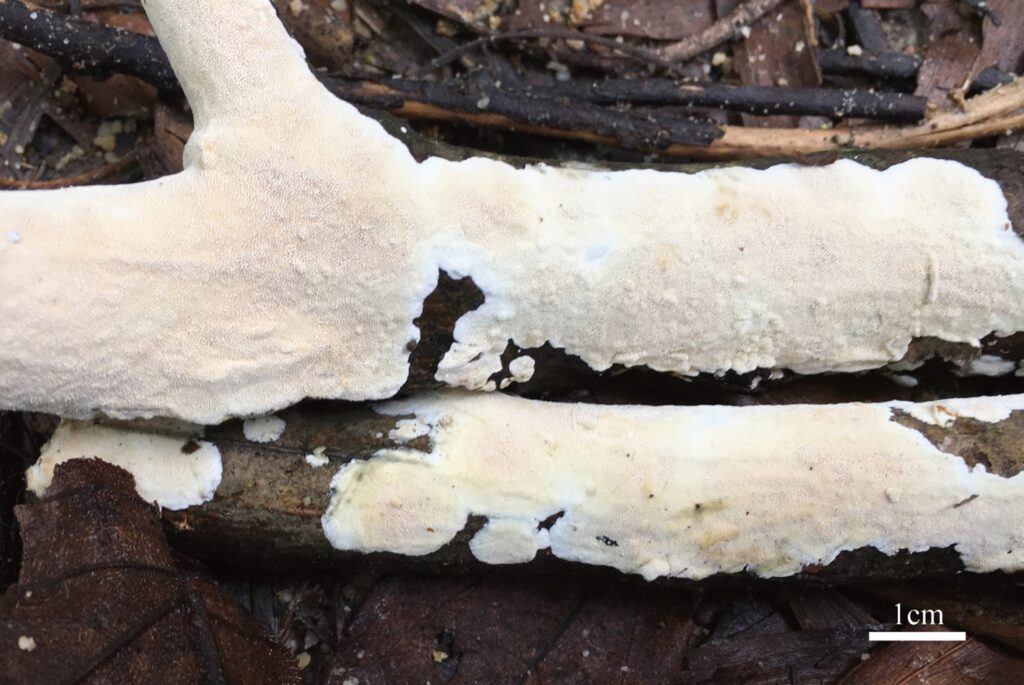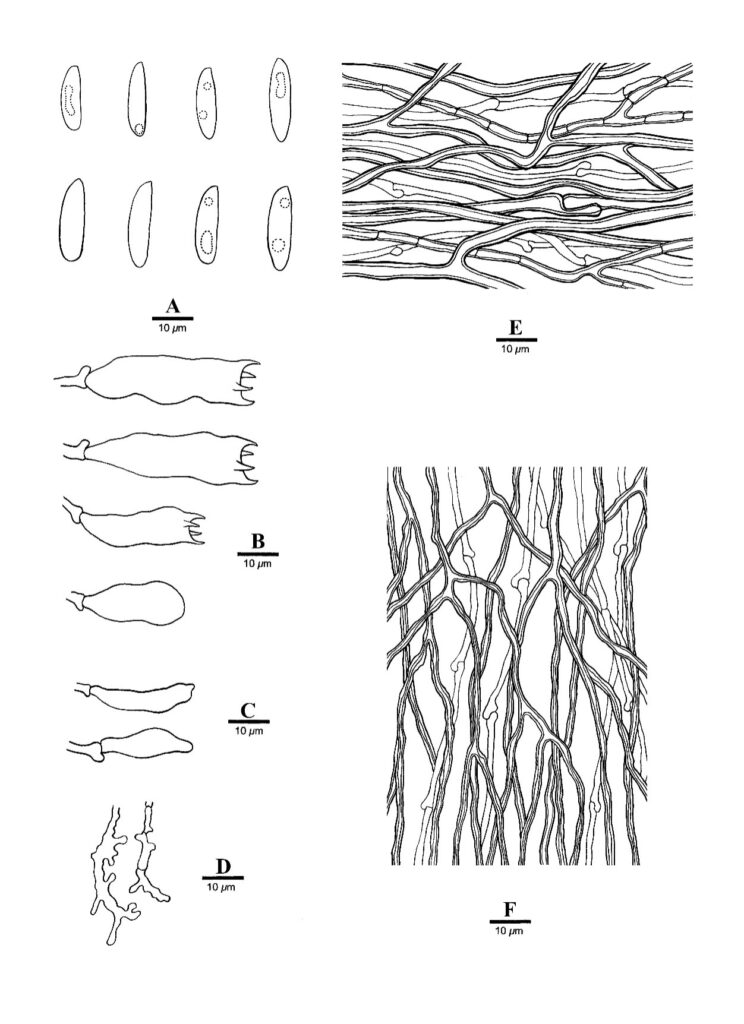Megasporia fusiformis
MycoBank number: MB 558812; Index Fungorum number: IF 558812; Facesoffungi number: FoF 10471;
Description
Basidiocarps annual, resupinate, corky, without odor or taste when fresh, becoming hard corky when dry, up to 11.6 cm long, 2.2 cm wide, and 0.4 mm thick at center; sterile margin distinct, white, up to 1 mm wide. Pore surface cream when fresh, cream to buff-yellow when dry; pores angular, 3.5–4 per mm; dissepiments thick, entire; subiculum cream, corky, up to 0.2 mm thick; tubes cream, paler than subiculum, corky, up to 0.2 mm long. Hyphal system dimitic; generative hyphae bearing clamp connections; skeletal hyphae sometime simple septate, IKI–, CB+; tissues unchanged in KOH (not dissolved). Subicular generative hyphae infrequent, hyaline, thin-walled, occasionally branched, 2–2.5 µm in diam; skeletal hyphae dominant, thick-walled with a narrow to wide lumen, frequently branched, occasionally simple septate, mostly flexuous, interwoven, 2.8–3 µm in diam. Tramal generative thin-walled, occasionally branched, 2–3 µm in diam; skeletal hyphae dominant, thick-walled with a narrow to medium lumen, frequently branched, mostly flexuous, interwoven, 2–3.5 µm in diam. Dendrohyphidia present. Hyphal pegs absent. Cystidia absent; cystidioles present, ventricose, thin-walled, smooth, 23.2–28.5 × 5.2–9.5 mm. Basidia clavate, usually constricted in middle, with four sterigmata and a basal clamp connection, 25.2–38.2 × 8.2–11.5 µm; basidioles in shape similar to basidia, but distinctly smaller. Small tetrahedric or polyhedric crystals frequently present among hymenium. Basidiospores fusiform, hyaline, thin-walled, smooth, sometimes with one or two guttules, IKI–, CB–, (14.1–)15–19.8(–20.2) × (4–)4.2–6.8(–7) µm, L = 17.59 µm, W = 5.12 µm, Q = 3.24–3.68 (n = 60/2).
Material examined: Malaysia. Selangor, Kota Damansara, Community Forest Reserve, on rotten angiosperm wood, 16 April 2018, Y.C. Dai 18596 (BJFC026884, holotype). on fallen angiosperm twig, 16 April 2018, Y.C. Dai 18578 (BJFC026866).
Distribution: Malaysia, Selangor.
Sequence data: Dai18596 (Holotype) – ITS: MW694892.1 (ITS5/ITS4); LSU: MW694935.1 (LROR/LR7); MTSSU: MW694920.1 (MS1/MS2); EF1a: MZ618637.1 (983F/1567R); Dai18578 – ITS: MW694893.1 (ITS5/ITS4); LSU: MW694936.1 (LROR/LR7); MTSSU: MW694921.1 (MS1/MS2); EF1a: MZ618638.1 (983F/1567R);
Notes: Morphologically Megasporia rimosa is similar to M. fusiformis by white to cream pore surface and extremely thin basidiocarp (less than 0.5 mm thick), but M. rimosa is different from M. fusiformis by its dextrinoid skeletal hyphae, cylindrical basidiospores and skeletal hyphae without any septa (Yuan et al., 2017). Phylogenetically M. fusiformis is closer to M. hexagonoides and M. rimose (Figures 1, 2), but M. hexagonoides differs from M. fusiformis by the bigger pores (0.5–1 per mm vs. 3.5–4 per mm), the absence of dendrohyphidia, and skeletal hyphae without any septa (Dai and Cui, 2008).

Fig. 1. Megasporia fusiformis (holotype). Basidiocarps of Megasporia fusiformis (the holotype, Dai 18596)

Fig. 2. Megasporia fusiformis (holotype). Microscopic structures of Megasporia fusiformis (drawn from the holotype, Dai 18596). (A) Basidiospores; (B) Basidia and basidioles; (C) Cystidioles; (D) Dendrohyphidia; (E) Hyphae from subiculum; (F) Hyphae from tube.
